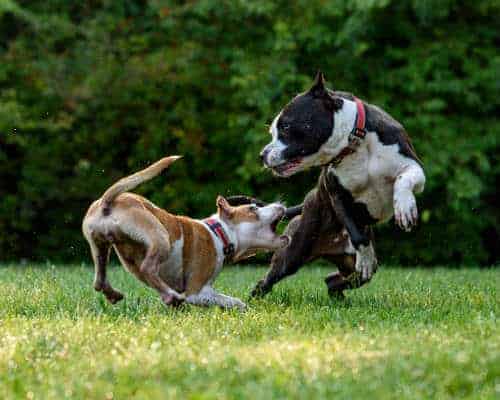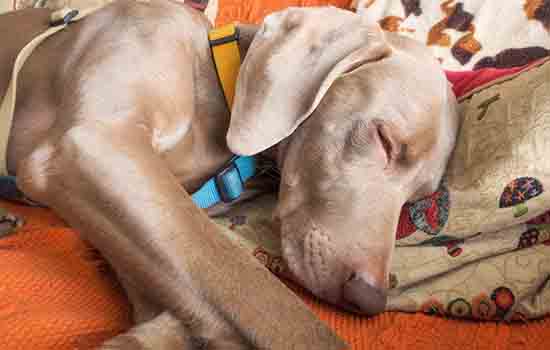Dog fights can be intense and frightening, but they usually last for just a few seconds. If you’re trying to break up a fight, the most important thing is to keep yourself safe. Humans can be easily injured by getting in the middle of a fight, and even a normally obedient dog may snap or lash out when in the middle of a fight.
Dogs often play and wrestle as a form of exercise and entertainment, but these playful fights can sometimes escalate. Dogs may also fight due to resource guarding, such as defending a food bowl or favorite toy. A dog fight may also be started when an unknown dog approaches and attacks another dog.
How to Safely Break Up a Dog Fight

When dogs are fighting, your goal is to break up the fight without incurring any injury to yourself or the dogs. Reaching into the middle of a fight with your hands is a good way to get bitten and is usually not very effective. Instead, you’ll want to distract or startle the fighting dogs so they stop what they’re doing:
- A loud noise might distract two dogs from fighting, especially if the fight is just starting. Yelling, clapping, or banging two pieces of metal together might be enough to get the dogs to look up, redirecting their attention to you. This gives you time to grab one of the dogs and physically separate them until they have the opportunity to calm down.
- Another method that works well for breaking up a dog fight is to get them wet. A splash of cold water is usually enough to shock all but the most determined dogs out of a fight. If you have a hose available, turning a blast into the middle of the fight will usually work.
- Physically placing a barrier between the two dogs may work as well. Using a sturdy walking stick or similar object to wedge between the dogs and separate them is better than reaching your hand into a fight.
Once you’ve gotten the dog’s attention, you will want to physically remove the animal from the scene. Reaching for the dog’s collar or scruff can work, especially if the dog is small enough to pick up. If the dog is larger, a better option is to grab the top of its hind legs and lift the dog into a wheelbarrow position. Begin walking backward and circling to one side with the dog’s legs firmly in your grip.
After the two animals are separated, removing them from view is important to de-escalate the fight and prevent another from starting. Place the dogs in separate rooms or in the car if necessary. Avoid interacting too much with the dog until he has calmed down as the adrenaline rush may leave a dog feeling keyed-up and snappish.
If your dog is on a leash when he starts to fight, drop the leash and use the wheelbarrow method to pull the dog away. Holding the leash can unwittingly pull you into the fight and can also cause injury if the leash becomes tangled or starts to choke the dog.
How to Prevent a Dog Fight

It’s much easier and safer to prevent a dog fight than to break one up that’s already started. Knowing how to read a dog’s body language is key to identifying how an interaction might go.
Dogs who are aggressive or nervous and frightened may lash out. When another dog approaches your pet, keep an eye out for body language that suggests discomfort on part of either animal:
- Stiff body posture
- “Whale eye” or wide eyes showing the whites
- Turning away with flattened ears
- Lip-licking or exaggerated yawning
- Stiff, short tail-wags
- Raised hackles
- Growling and snarling
Some dogs are very vocal and can make scary-sounding noises while playing. You can usually tell by looking at a dog’s overall posture whether he is playing or actually intent on a fight.
It’s important to remember that the instigator in a dog fight is not always the larger dog. Small dogs can and will pick fights with larger dogs at times even if they are at a disadvantage.
Certain breeds also may be more prone to getting into dog fights. Greyhounds, for example, often have different body language than other breeds and may misread the signals of other dogs, making them more likely to set off a strange dog’s temper. Pitbulls and other “fighting” type breeds are also sometimes more dog-aggressive and may give off more subtle warning signs before engaging in a fight. However, these are just general trends and guidelines; knowing your own dog’s temperament and limitations is the key to safely preventing a fight.
How to Reduce Dog Aggression

Some dogs are naturally more prone to aggression toward other dogs. However, there are things you can do to limit a dog’s level of aggressiveness and promote better behavior:
- Do not encourage competition. Teasing dogs and provoking them teaches bad habits that can grow dangerous. If you know a dog gets territorial about his treats, toys, or food, avoid creating a situation where another dog might try to take them. Let the dog enjoy the toy when alone, and remove it from the room when another dog is present.
- Work on training appropriate behaviors. During calm times, work on training a dog away from resource guarding behaviors. You can consult with a professional dog trainer on the best way to do this.
- Break up rough play or bullying. Sometimes a dog isn’t good at respecting another dog’s signals, and it’s your job to step in to intervene when play gets too rough.
Whenever interacting with excited, frightened or aggressive dogs, the most important thing is to remain calm and assertive. Allowing yourself to get worked up will just ramp up the energy and exacerbate the situation.
